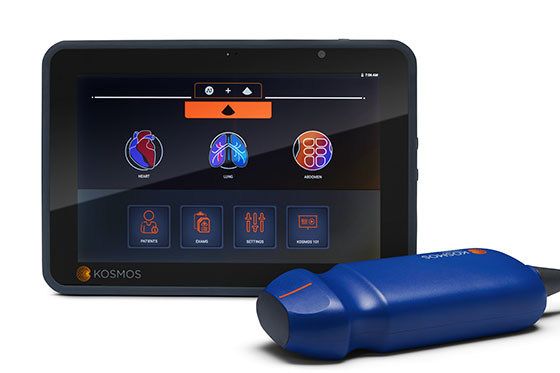EchoNous Secures FDA Clearance for Hand-Held Ultrasound Scanner
Eight-ounce scanner assesses heart function.

The U.S. Food & Drug Administration (FDA) has awarded 510(k) clearance to the hand-held ultrasound platform Kosmos, produced by the developer EchoNous.
By using machine learning, Kosmos can imitate humans’ learning and decision-making processes, according to the company. The 8-oz ultrasound tool has embedded and synchronized ECG and digital auscultation. Currently, the tool measures systolic heart function.
In addition, EchoNous has side-stepped the need for cloud connectivity with the Kosmos Bridge, a tablet that accompanies the platform. All artificial intelligence functions run on the tablet, ensuring there are no service failures during scans, EchoNous officials said. It is also designed to connect with a health system's IT system without a need for internet connectivity.
According to EchoNous officials, the Kosmos platform has been tested with more than 300 patients in acute care settings in the United States, Canada, Europe, and Japan. It will be available in the U.S. market for less than $10,000.
As a next step, company officials said, EchoNous plans to file for FDA clearance for a trio of algorithms that will allow users use machine learning algorithms to grade image quality, guide their technique, and label heart anatomy.
New AI-Enabled Portable Ultrasound May Facilitate 50 Percent Reduction in Cardiac Imaging Scan Time
March 28th 2025Artificial intelligence (AI)-powered measurement capabilities provide key features with the Compact Ultrasound 5500CV device, which was unveiled at the American College of Cardiology (ACC) conference.
The Reading Room: Racial and Ethnic Minorities, Cancer Screenings, and COVID-19
November 3rd 2020In this podcast episode, Dr. Shalom Kalnicki, from Montefiore and Albert Einstein College of Medicine, discusses the disparities minority patients face with cancer screenings and what can be done to increase access during the pandemic.
Can Ultrasound-Based Radiomics Enhance Differentiation of HER2 Breast Cancer?
March 11th 2025Multicenter research revealed that a combined model of clinical factors and ultrasound-based radiomics exhibited greater than a 23 percent higher per patient-level accuracy rate for identifying HER2 breast cancer than a clinical model.